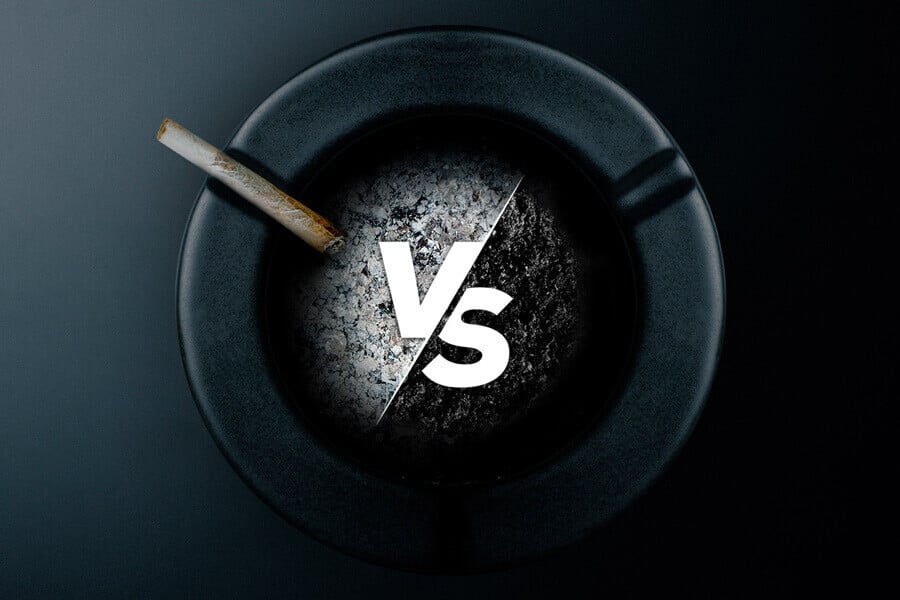Black vs White ash

Some cannabis connoisseurs firmly believe that one of the signs of quality grown weed is when a joint burn produces only white ash. Conversely, they also believe that black-coloured cannabis ash is a sign of excess residual minerals, a sign of poor flushing perhaps? But are these beliefs true, or is the desirability of cannabis white ash merely a myth with limited foundation in science?
Cannabis white vs black ash facts and misconceptions
Many assume that white ash is a sure sign that your cannabis was properly flushed, dried and cured. Black ash is therefore believed by many to be a sign of residual mineral nutrients including phosphates & nitrates along with any other “impurities”. It’s worth noting that the ‘NPK’ mineral nutrients (inorganic salts rich in Nitrogen, Potassium and Phosphorus) typically used to feed cannabis are typically white crystalline solids at room temperatures. Black ash is dark coloured because of residual carbon remaining after incomplete combustion. This could be caused by several factors, discussed below.
Key factors influencing the colour of cannabis ash
When the usual materials in a cannabis joint (ground weed with possible addition of tobacco, cannabis oil, concentrates & hash) are ignited they combine with atmospheric oxygen and burn. With complete combustion, all organic materials either evaporate (and are inhaled/) or they are burnt, oxidising into an array of organic compounds and CO2. Some of these are inhaled, the rest escapes as smoke and dissipates.
The remnants of efficient, complete combustion are typically inorganic (i.e. carbon-free) remains that are carbon-free and therefore a natural white (or white/light-grey) colour. But note that ash from any cannabis joint will contain non-combustible inorganic remains (nitrates, phosphates, carbonates, oxides of Sodium, Potassium, Calcium, Magnesium etc) even if you believe you have correctly flushed your plants. One point to be discussed later is whether flushing cannabis actually has any scientific merit at all.
If you have ever used an efficient log burning stove, you will notice that wooden logs burn leaving an often white/grey ash behind. This material is, as with cannabis, simply the inorganic remnants that are left once combustion is complete. Rich in useful minerals, ash from wood fires has traditionally been re-used as a natural soil fertiliser.
When combustion is incomplete more non-oxidised (or unburnt) black carbon is left leaving a visibly darker (black, dark grey) coloured ash. It doesn’t matter how well the weed was grown, flushed or cured. If combustion of the joint ingredients is incomplete, for whatever reason, you will have darker coloured ash.
Below are a few factors that are often thought to affect whether your weed burns leaving a white or black ash behind.
Resin levels in the cannabis buds
The best cannabis seeds will produce plants that exude far higher levels of resin than average. But whether you are growing genetics that will produce sticky buds with 25% THC levels or something not quite as potent you should still see cannabis trichomes on the leaves and buds.
Cannabis trichomes are the small sticky glands that contain THC (and other cannabinoids) as well as terpenes. These compounds are generally organic with low boiling points – meaning that they turn to volatile gases on contact with heat and are inhaled.
If you roll good joints that burn evenly (a key requirement for producing white ash) all the trichome material should completely combust/evaporate. If you roll joints that don’t burn particularly evenly then residual tar from the trichomes may stain the ash a darker colour.
Type and age of cannabis
Many believe that well cured and aged cannabis buds are more likely to burn leaving a white ash behind. One of the reasons behind this theory is that it allows time for the plant pigment chlorophyll to degrade – which is certainly true, and this does improve the taste.
For all connoisseurs, curing is the process that allows weed to mature allowing the buds to dry slowly and the fresh chlorophyll taste to diminish. Well cured buds may taste better but curing them doesn’t remove the inorganic salts/minerals which are the primary constituents of white ash. Freshly harvested, as well as expertly cured, cannabis buds can produce cannabis ash that is white or black.
Smoking method and burning temperature
If you vape your buds, you always get a brown cellulose plant residue. All the volatile cannabinoid and terpenes are inhaled, and you are left with the dry remnants of the host plant.
If you light a joint, the combustion process ignites the organic plants materials. It is the efficiency of this combustion process that determines the colour of the ash.
A consistent burn with sufficient oxygen (therefore inferring higher joint temperatures) will oxidise any remaining carbon into CO2 or other volatile organics. An inconsistent burn down your joint will leave charred, blackened carbon-rich ash.
Whether you roll expert-joints that burn evenly all the way down or whether your joint-rolling technique leaves a little to be desired, the ash will always contain non-combustible inorganic matter. The more efficient the combustion process, the whiter your ash will be. If your joints burn down unevenly then the contents inside the joint receive inconsistent levels of heat therefore lending themselves towards blacker ash.
Curing process
During cannabis curing any excess moisture evaporates from the buds until they reach the desired moisture content. Throughout this aging process the buds often fade from fresh-green to duller green/brown hues. Chlorophyll degradation is the reason for the colour change, which results in a better taste as the terpenes can better express their loud flavours.
But despite many counterclaims, cured buds are no more likely to burn with a whiter ash than uncured buds. They may taste and smell far superior, but it is the process/efficiency of combustion that determines how much carbon is left in the ash – and therefore what colour that ash will be.
What about tobacco ash?
Over the last 100 years the tobacco industry has also explored the topic of ash colour. Presence of Chlorides (not used as a primary constituent cannabis nutrient BTW) inhibits complete combustion, restricting the full depth of flavour and aroma. It is quite possible that cannabis aficionados noticed the same principle – when combustion is complete the taste/effects are better, and the ash colour is whiter.
Note that inorganic materials (typically low levels of Magnesium or Calcium salts) were often added (!) to cigars to promote a fine white ash colour. Many health-conscious cannabis users, mindful of the combustion concerns have chosen to bypass the debate simply by switching to a cannabis vaporiser.
For many, combustion feels like a riskier process compared to the relative simplicity of gently ‘toasting’ your buds (or nicotine/tobacco) via a vape which slowly releases the vapours without combustion and the various potentially harmful by-products.
Cannabis flushing for the win and the whitest ash…or is it?
One highly controversial topic within the cannabis community is that of flushing. Many believe that flushing or offering only water (with no nutrients) for the last couple of weeks is the best way to ‘flush’ inorganic salts/nutrients out of your buds. Well-flushed buds are often considered to burn better, producing a smoother smoke and a whiter ash.
However, there are two issues with this theory:
• Firstly, it is actually the presence of inorganic (and the absence of residual carbon) that makes cannabis ash white.
• Secondly, there has been clear scientific evidence in recent years that flushing has no effect whatsoever on the levels of Nitrogen, Phosphorus or Potassium in the dry buds.
• Furthermore, flushed buds didn’t have superior THC or terpene levels. And of greatest interest is the fact that, in blind trials of flushed vs non-flushed buds, most people preferred the taste of non-flushed buds. Perhaps depriving your plants of nutrition prior to harvest compromises some aspects of plant biochemistry which adversely affects bud quality. Flushing certainly doesn’t wash minerals out of the plants and back into the grow medium.
If you want a deeper technical dive into the scientific study that claimed to totally debunk the value of flushing, then check out this article which also includes a video featuring the authors of the scientific study being interviewed about their findings.
ow to evaluate the quality of cannabis beyond ash colour
The colour of the ash from your joints really can’t tell you too much about the quality of your weed. Instead, there are several other more important indicators, all of which you can control.
• For best results, Dutch Passion recommend growing with quality LED grow lights.
• Those that have struggled with the yo-yo effects of over/under-feeding mineral nutrients to their plants may find better results with slow-release organic nutrients. BioTabs are market leaders with a well-deserved reputation for making growing easier, especially for those with less cultivation. experience. Buy your BioTabs starter pack here.
• Use of large, aerated grow containers such as airpots or felt sacks are also highly recommended.
Appearance
With even a little experience it’s easy to discern the difference between magnificent buds and cheap bag weed. Badly grown weed may lack bud density and structure, perhaps through insufficient lighting and/or poor nutrient management. Get your grow conditions right and your plants, blooms and the buds on them will have a solid chunky, healthy appearance.
Source: Dutch Passion





